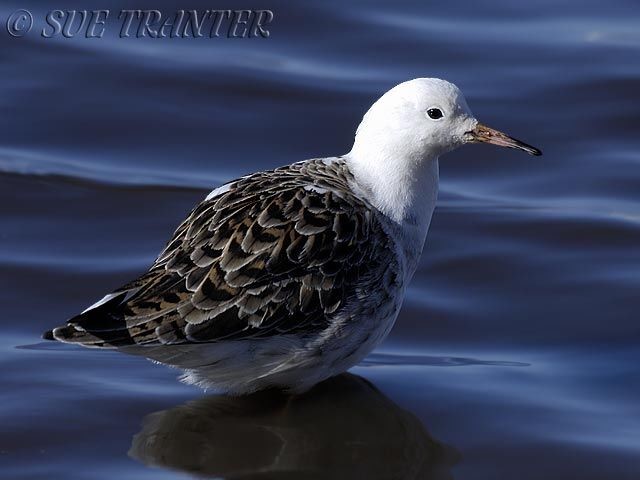 |
| Ruff: March, Lancs According to BWP, in central Europe males have ruffs and ear-tufts predominantly dark-coloured and in southern Scandinavia they are generally white. In winter, obvious white-headed males make tracking their movements between local sites straightforward. (photo: Sue Tranter). |
Few birders will have passed through their birdwatching apprenticeship without being tricked by the humble Ruff at some stage. This master of disguise does good impersonations of many species, whether it be an all-black male resembling a Spotted Redshank, or small buffy juvenile masquerading for the unwary as a rare Buff-breasted Sandpiper.
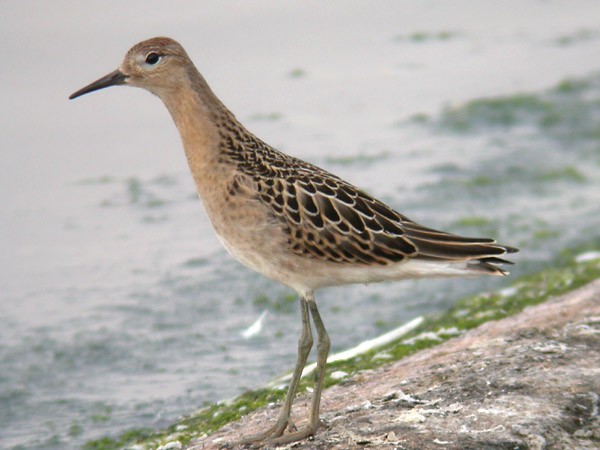 |
| Ruff: August, Lincs Juveniles can be deceptive and come in a variety of sizes, and tones, to add to the confusion. The underparts are buff-coloured, though the breast-sides are plain, unlike the neatly spotted breast-sides of Buff-breasted Sandpiper. Also lacking in Ruff is the obvious pale eye-ring and mustard-yellow legs of the rarer species. (photo: Russell Hayes). |
Ruff is perhaps best known for the fantastic splendour of the males, which can take any colour from black, ginger and white. Their gaudy adornments are appreciated to their best at a 'lek', where the males seek to outdo one another to capture the attention of the much drabber 'reeves', who look on.
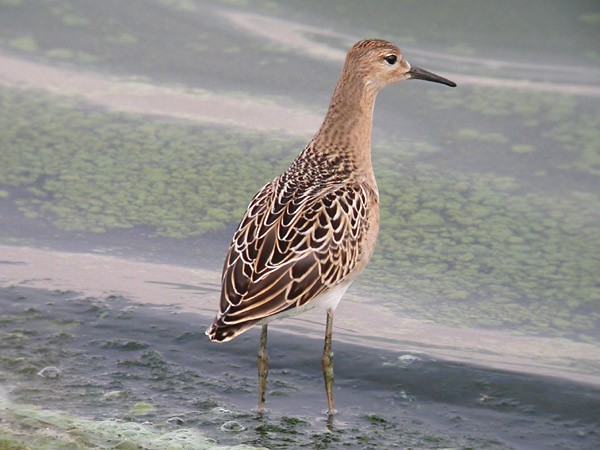 |
| Ruff: August, Lincs Unlike Buff-breast which has a long primary projection, Ruff show noticeably long tertials and the pale mantle Vs of Ruff are unlike the neatly scalloped patterning found on Buff-breast. (photo: Russell Hayes). |
Ruff was once a widespread breeding species in Britain, but became practically extinct as such after the middle of the 19th century. After this pairs were noted in Lincolnshire in 1882, Durham in 1902, Lancashire in 1910 and Norfolk in 1922. Regular breeding did not occur again until 1963. Although the number of sites at which birds have been present in suitable habitat during the breeding season has increased in recent times (a maximum of 21 sites in 1992), the number at which leks are attended has yet to exceed the 10 recorded in 1987.
The majority of the European population outside of Russia (105,000-139,000 pairs) are found in Northern Scandinavia. The British breeding population is very small indeed with the number of nests/broods in single figures, though in many years none are recorded and in recent years just a few leks have been observed; see Rare Breeding Birds in the United Kingdom in 2001).
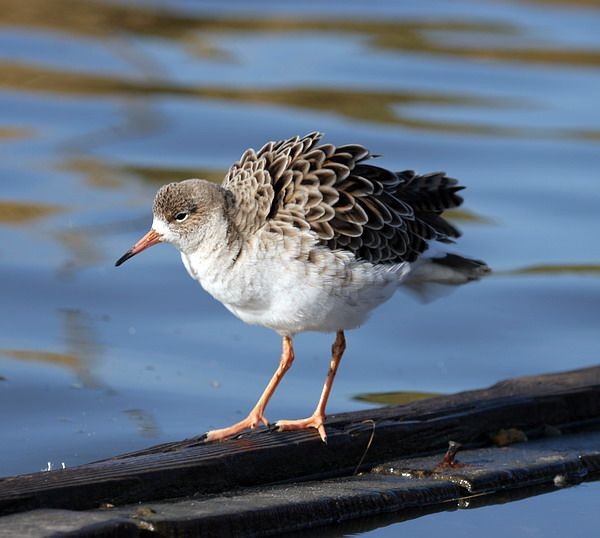 |
| Ruff: February, Lincs Ruff have only been recorded wintering in Britain and Ireland since 1934. Numbers increased to over a 1,000 in the 1970s, but have since declined to around 400. Ringing recoveries from eastern Siberia perhaps hint at the likely origin of some of our wintering birds, though numbers are relatively small and just seven sites held 50 or more birds during the winter 1999/2000 and just five had a five-year mean exceeding this number for the period 1995/96-1999/2000. (photo: Dean Eades). |
Fortunately, Ruff is a regular passage bird and wintering visitor. Though the total winter range extends from western Europe and West Africa eastwards to India, by far the largest numbers winter in Africa and these include even birds from north-east Siberia (those reaching South Africa having travelled 15,000 km). In spring, during easterly airflows, the westward drift of northbound birds from the main wintering areas in Africa can produce sizeable gatherings at east-coast locations. Likewise, as a passage bird in the autumn, large influxes of juvenile birds displaced westwards take place from time to time. During such occasions the species seems to occupy every coastal puddle and inland water. In some areas of the UK birds are present nearly year-round and several preferred wintering sites can sometimes accommodate three-figure numbers.
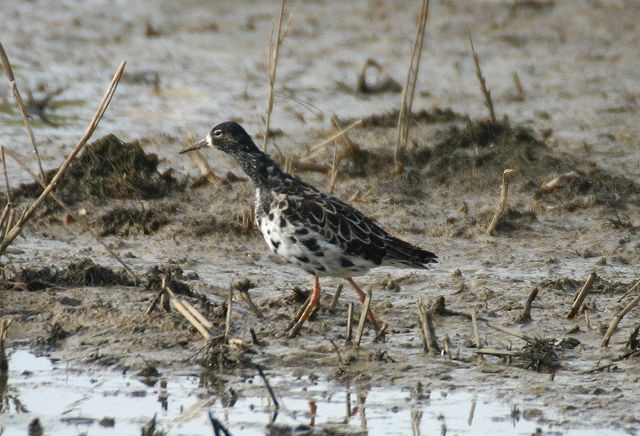 |
| Ruff: April, Norfolk Some birds can be quite dark, perhaps leading to potential confusion with other species, especially at sites where there are no other waders for comparison. (photo: Chris Cook). |
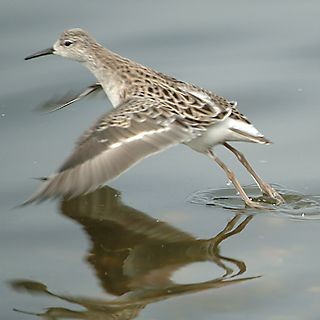 |
| Ruff: March, Lancs In flight Ruff show an indistinct wing-bar, but more obvious are the white ovals at the sides of the uppertail. In flight the legs extend noticeably beyond the tail. The flight action is lazy, lacking the urgency of many wader species. (photo: Sue Tranter). |
 |
 |
| Ruff: May, Northumbs With male Ruff, virtually any colour goes – this one attempting the Spotted Redshank look perhaps? (photo: Alan Gilbertson). | Ruff: July, E. Yorks Males following their breeding season peak can often appear rather disheveled! (photo: Howard Broughton). |
 |
 |
| Ruff: August, Norfolk The bill is slightly curved, which coupled with the small-headed appearance creates quite a distinctive appearance. (photo: Peter Simpson). | Ruff: December, Lancs The pale bill surround is noticeable from quite some distance. Non-breeding males can show bright orange legs and bill bases, inviting confusion with Redshank. (photo: Sue Tranter). |
 |
 |
| Ruff: October, Lancs The underwing lacks the obvious dark crescents on the primary coverts of Buff-breasted Sandpiper. (photo: Adrian Dancy). | Ruff: October, Lancs Birds can appear quite nondescript, often appearing as something slightly more interesting, especially when small solitary birds are encountered. (photo: Adrian Dancy). |
The Buff-breasted Sandpiper 'problem'
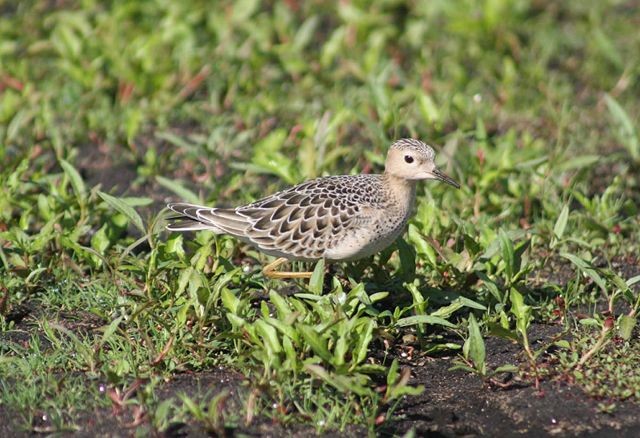 |
| Buff-breasted Sandpiper: September, Cornwall The mustard-yellow legs, a wader constantly on the move and plumage details instantly point towards a scarcity. As is often the case the 'genuine article' is very obvious. More often than not, if you 'think' you've 'got' a Buff-breast then you probably haven't! (photo: Rob Laughton). |
Although Ruff are often confused with many different species the perennial misidentification for the unwary tends to occur where small juvenile birds are an identification pitfall with Buff-breasted Sandpiper. However, when seen well enough Buff-breast should not really cause too much confusion. But, the problem is always there, and any would-be claimant of a Buff-breast should always have gone through the mental process of this potential 'googly'.
In 2002 a Buff-breasted Sandpiper was present at my local patch at Bank Island, North Yorkshire. Also at the site were a number of Ruff, including a small juvenile, and I recall seeing a number of birders who had travelled to see the Buff-breast confidently comment that they 'were on it', only for the bird they were watching to be the small Ruff. So, even experienced birders can be fooled. Anyone interested in the identification points for Buff-breasted Sandpipers is referred to an earlier BirdGuides article looking at this superb Nearctic wader (click here).
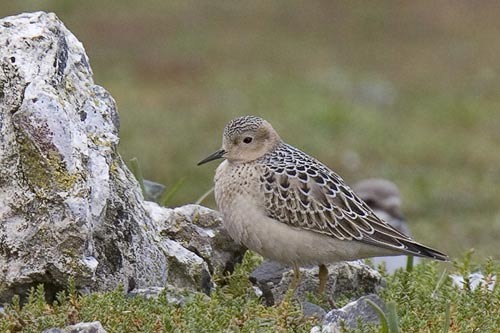 |
| Buff-breasted Sandpiper: August, Lothian Note the long primary projection, pale eye-ring and spotted breast sides. (photo: Ray Wilson). |
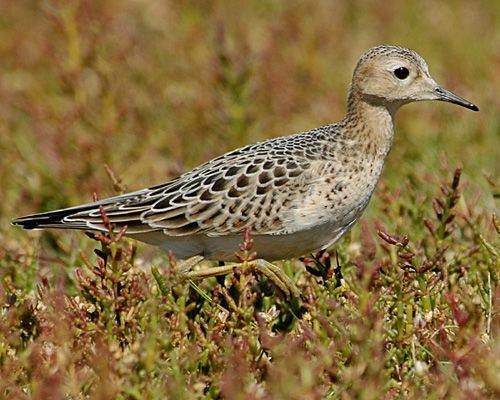 |
| Buff-breasted Sandpiper: September, Co. Wexford Compared with Ruff the bill is shorter and straighter and black. (photo: Paul and Andrea Kelly). |
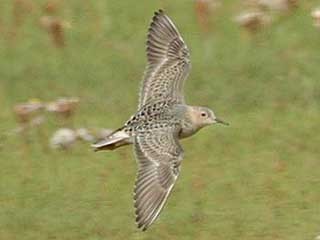 |
 |
| Buff-breasted Sandpiper: September, Co. Wexford The legs do not extend beyond the tail as in Ruff, and the upperparts are quite plain, recalling a small Golden Plover – Buff-breasts are only Dunlin-sized and many observers unfamiliar with the species are surprised at how small they actually are. (photo: Paul and Andrea Kelly). | Buff-breasted Sandpiper: August, Lothian The dark underwing crescents are very striking on birds in flight. (photo: John Anderson). |
References
Cramp and Simmons. 2004 Birds of the Western Palearctic interactive. Published by BirdGuides, Sheffield.
Birdlife International. 2004. Birds in Europe: Population estimates, trends and conservation status. Cambridge, UK: Birdlife International. (Birdlife Conservation Series No. 12).
Brown and Grice. 2005. Birds in England. Poyser, London.
Svensson, L., Grant, P.J., Mullarney, K., Zetterstrom, D. 1999. Collins Bird Guide. HarperCollins, London.


